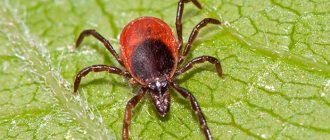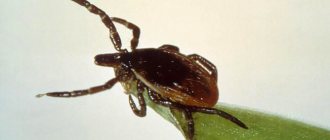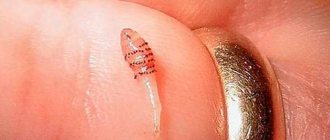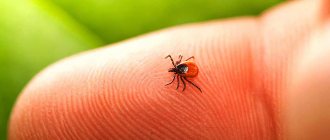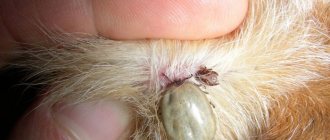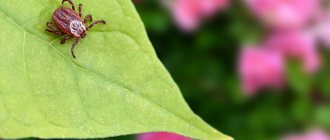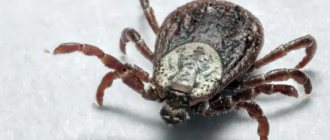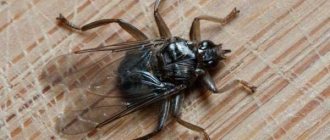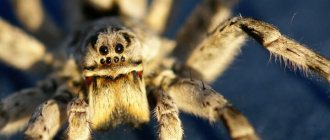With the onset of warmth, not only nature and all living things wake up along with it; in the spring, harmful parasites also awaken. On the territory of Russia, ticks are the most threatening to humans. The reason for their danger is that these blood-sucking pests can live and parasitize on the human body for a long time, and even infect it with fatal diseases through the blood.
Ticks: what they look like and their structure
Few people know that ticks do not belong to insects. They are assigned to the kingdom - animals, phylum - arthropods, class - arachnids. This also includes spiders and scorpions, and they are all considered animals! Their body is not divided, like insects, into sections, but has two segments - the head and the body. The head consists of a base and a proboscis. And the body is an abdomen on which the legs are attached. It is the abdomen that is the most important and dangerous part, since infectious agents are concentrated in it.
The body coverings of the pest are heterogeneous - partly hard, and in places soft and elastic. It is precisely because of their unique and unusual body features that they are able to stretch and absorb significant volumes of blood, while increasing their weight by 100 times or more. There are a huge variety of ticks. They differ in shape, size, color and even structure. However, there are a number of common features that are characteristic of such parasites:
- oval body shape;
- neutral body color;
- 4 pairs of paws;
- absence of antennae;
- lack of eyes.
Tick-borne pests are able to sense their prey at a considerable distance due to the presence of well-developed sensory organs and thermoreceptors. To navigate in space, they use their special sensitive apparatus. Parasites find their victims based on characteristics such as body heat, smell, vibrations, moisture and even sometimes ordinary shadow.
Due to the fact that they cannot fly or jump, their main way of getting at a potential feeder is to attach themselves to his integument or areas of clothing. Waiting for owners occurs on tree branches, bushes and even grass. Having waited for a living creature to approach, the ticks cling to it with their front paws, while holding onto the plants with their hind paws.
When feeding, as a rule, complete penetration under the skin does not occur. Pests only bite through it a little, being mostly on the surface. They are sucked on due to their powerful mouthparts, which allow them to firmly adhere to the skin. For this reason, it is sometimes not so easy to get rid of the dirty trickster, or even remove it at all.
When bitten, it releases a special anesthetic substance, which makes it possible not to feel the moment of the bite. But in rare cases, over time, this area can become locally inflamed and become painful and noticeable.
The parasite is quite difficult to notice on the body in the first few days after suction, unless you look for it purposefully. This is due to its extremely small size. Later, as a result of abundant nutrition, it begins to increase in size. The bite itself usually passes without consequences, but small children may develop an allergy. The contact area becomes inflamed, slightly swollen and itchy.
Symptoms most often disappear on their own within a few days. But the main danger still comes not from the tick itself, but from the pathogenic microorganisms (bacterial and viral) that it carries.
Most species of ticks reproduce using eggs, although viviparous species are also found in nature. They are also divided into 2 sexes - females and males. Blood-sucking parasites have the most interesting life cycle, which includes the following stages of development:
- Egg;
- Larva;
- Nymph;
- Adult.
Closer to summer, the female is properly saturated with blood, and then begins to lay eggs. Their number is numerous and can reach several thousand pieces! After this, within a month, larvae emerge from the eggs, which look very much like adults. They just differ in their smaller sizes and the absence of one pair of legs. Their body is still developing, so it makes sense that some parts might be missing.
The highest activity of larval emergence occurs in the warm season. But it is worth noting that very few survive after birth. Due to their small size, their main feeders are hedgehogs, lizards and small rodents.
According to the conclusion of American experts, the bite of a larva poses the same threat as the bite of an adult. This is especially true in relation to those varieties that carry dangerous diseases such as encephalitis. While on the body of its owner, the larva is saturated with blood for 6-7 days, after which it falls off and ends up on the ground.
Then the next stage of its development begins - the nymph stage. For a nymph to transform into an adult, it takes one year, and sometimes more time. During the entire period of growing up, the parasite only needs to feed itself a couple of times. The lifespan of different types of mites is different and varies from several days to several years. For example, the dust type lasts no more than three months, while the taiga type can live for about four years. Moreover, they can all go without food for months or years.
Fortunately for us, even pests have their ill-wishers who hunt them as a source of food. Such enemies are: lizards, ants, birds, wasps, frogs, dragonflies and spiders. By exterminating bloodsuckers, they provide benefits to potential victims of these parasites.
Scabies lesions
Foci of the disease are family and collective.
- The leading factor in the epidemiology of scabies is the family outbreak. In 90% of cases of disease, the pathogen is introduced into the family by one of its members, much less often - by relatives and friends who do not live in the family. The primary sources of infection in family outbreaks are persons aged 17–35 years, most often children and husbands. In half of sick adults, infection occurs through sexual contact. The direct route of infection (contact with a patient) is the main one. Indirect transmission of infection (through household items and bedding) occurs in 13% of cases.
- Organized communities in which scabies can be transmitted are divided into two groups. The first group includes groups where people have common bedrooms (orphanages, dormitories, boarding schools, etc.). The incidence of scabies in such groups is two times lower than in families.
The second group includes teams where all members are in contact with each other during the daytime (kindergartens, schools, secondary and higher educational institutions, work collectives). Collectives of the second group do not pose an epidemiological danger.
Family outbreaks of scabies are the main sources of patients in society.
Types of ticks
Currently, scientists know more than 50 thousand varieties. Their diversity is so great that they have colonized all continents and climate zones. But still the main habitats are forests and meadows. Different species lead different lifestyles from each other. Among them there are predators, saprophytes, parasites, pests for plants, animals and people. But not all representatives are dangerous to humans; most of them feed on decaying organisms.
Most often, the size of the bloodsucker starts from 1 mm and does not exceed 3 mm, but there are exceptions. The Guinness Book of Records records the following cases:
- The largest can reach a length of 30 mm - ixodidae (lxodidae).
- The smallest ones do not exceed 0.08 mm - acariform (Acarina).
Tick-borne parasites are effective carriers of pathogens of infectious diseases, the range of diseases of which depends on the area and the species origin of the pest. Different individuals have their own characteristics: some never attack a person, others only in rare and exceptional cases, and for others, a person is a habitual victim. The following families mainly attack people and animals:
- Ixodidae (Ixodidae),
- Gamasoidea,
- Red beetles (Trombidiidae),
- Argasidae.
Not dangerous for humans and animals:
- Barn (Acarina),
- Aquatic (Hydracarina),
- Armored (Oribatida),
- Arachnoids (Tetranychidae).
Pests that can parasitize inside the human body for a long time:
- Subcutaneous,
- Ciliary,
- ear,
- Scabies.
Symptoms of the disease
Symptoms of European encephalitis at the first stage of the disease
Irritation at the site of the bite quickly passes, and the person forgets about the incident. But after 1-2 weeks he feels unwell and does not in any way connect this with the arthropod that bit him.
At the first stage, it is very difficult to distinguish between encephalitis infection and other diseases, of which there are a good dozen. And not all of them are contagious.
The main symptoms of European encephalitis in the first stage, lasting 2-4 days:
- muscle pain;
- lack of appetite;
- headache;
- fever;
- nausea, possibly with vomiting;
- general malaise.
At this stage, it is easy to confuse encephalitis even with regular flu and try to self-medicate. After 8 days (the period of complete recovery from the flu), remission occurs. The patient sincerely believes that it was the flu and forgets about the disease. If you're lucky, there will be no consequences of encephalitis.
But in 20-30% of infected people, after remission, the second stage of the disease follows with damage to the central nervous system:
- meningitis: severe headaches, tense neck muscles (similar to myositis), fever;
- encephalitis: impaired coordination of movements up to paralysis, sensitivity disorder, disturbances of consciousness;
- mixed form, which will “delight” with simultaneous signs of encephalitis and meningitis.
Far Eastern encephalitis develops more rapidly. It begins with a sudden increase in body temperature to 38-39°C. Severe headache and nausea appear. Sleep is disturbed. There is no remission stage. After 3-5 days, damage to the central nervous system develops.
It doesn’t matter what color the tick managed to dig into the body. In terms of transmission of infection, there is no difference between them
Moreover, in an infected area, any blood-sucking organism that parasitizes mammals can be dangerous. To prevent infection, it is necessary to follow safety measures and get vaccinated against encephalitis in advance.
Sources
- https://hlopklop.com/o-kleshhah/gde-obitayut.html
- https://TaraKlop.ru/kleshchi/gde-zhivut-kleshhi/
- https://prusakam.net/entsefalitnyj-kleshh/
- https://TaraKlop.ru/kleshchi/encefalitnye-kleshhi-v-rossii/
- https://domovod.guru/borba-s-vreditelyami/kleshhi/ukus-kleshha/entsefalitnyiy-kleshh-foto.html
- https://medyunion.ru/diseases/kleschevoj-entsefalit/
- https://felisov.ru/kleshchi/otkuda-poyavilis.html
- https://PokemonGoy.ru/kleshchi/zhivut-li-na-derevyah.html
- https://apest.ru/kleshhi/vidy-kleshhej/encefalitnyj-kleshch/
- https://zdorrov.com/bolezni-vzroslyh/entsefalitnyj-kleshh.html
Diseases transmitted by ticks
It has been established that pathogens are concentrated in the abdomen of the pest, and the source of the disease is the salivary glands. And therefore, if a tick is infected with an infection, then when it sucks blood with saliva, it will certainly transfer it into the blood of a person or animal. That is why it is very important to remove the attached enemy as early as possible in order to prevent infection.
Tick-borne infections have varying severity of disease, since their carriers are capable of infecting with pathogenic microorganisms, viruses, bacteria and protozoa. Ticks are also intermediate hosts of some helminths and mechanical carriers of dermatobiasis pathogens. For our country, it is the ixodid species that pose a threat, which is the main source of the most common tick-borne diseases.
But even bites from uninfected individuals cause consequences such as skin lesions and sometimes cause paralysis. The first signs of a bite are: increased temperature, fever, weakness, migraine, skin irritation, muscle and joint pain. The most common and dangerous diseases transmitted by ticks:
- Tick-borne viral encephalitis.
- Tick-borne borreliosis (Lyme disease).
- Tick-borne monocytic ehrlichiosis.
- Granulocytic anaplasmosis.
- Tularemia.
Tick-borne viral encephalitis
Tick-borne encephalitis is an acute infectious viral disease, the essence of which is damage to the brain. This disease is recognized as the most dangerous and widespread that ixodid ticks can carry. The causative agent of the infection is an arbovirus, which is transmitted when a parasite bites along with its saliva contaminated with the virus.
There is another route of infection - consumption of raw milk of artiodactyl animals, whose pastures are in the habitat of pests. The incubation period takes mainly 10-14 days, in some cases it can reach 60 days. The onset of the disease is acute and is characterized by a sharp increase in temperature to 38 or 39 degrees. Other symptoms:
- chills,
- headache,
- lethargy,
- brokenness,
- mild lower back pain,
- temperature increase,
- redness of the skin and mucous membranes,
- nausea and vomiting,
- muscle weakness,
- numbness of the skin of the face and neck.
Susceptibility to the disease and the course of the disease varies from person to person. The duration of blood sucking and the presence of the parasite on the human body is of great importance. The earlier it is detected and removed, the less likely it is that the virus will enter the victim’s body. Treatment:
In the first 72 hours after an encephalitis tick bite, it is recommended to carry out special treatment, which consists of administering anti-tick immunoglobulin.
Also in the medical institution there are preventive vaccinations that can be done before a possible bite and the onset of the disease.
There is no specific treatment for this disease; doctors resort only to supportive therapy.
The prognosis for tick-borne encephalitis depends on the degree of damage to the nervous system and the form of the disease:
- Febrile is a mild form in which all patients, as a rule, fully recover.
- Meningeal - the average form, which is accompanied by positive dynamics, but in advanced stages persistent neurological consequences can occur in the form of constant headaches and chronic migraines.
- Focal is a severe form, the most unfavorable prognosis among all. Mortality statistics are: 30 people per 100 cases. Complications of this form are the occurrence of persistent paralysis, convulsive syndrome, and decreased mental abilities.
The consequences of the disease in certain cases are problems associated with the central nervous system and cognitive impairment. The most common complications include:
- cerebral edema,
- onset of coma,
- cerebral hemorrhages,
- problems with the gastrointestinal tract,
- epilepsy,
- breathing disorders,
- cardiac dysfunction,
- infectious-toxic myocarditis,
- loss of consciousness
- deterioration of vision and hearing.
The worst thing is that with deep disorders, the restoration of motor function in patients occurs to an insufficient extent. In this case, there are two outcomes of events: either they remain disabled for life, or they die. The fatal outcome for Russian spring-summer tick-borne encephalitis is 25%, and for European tick-borne encephalitis - 5%.
Tick-borne borreliosis (Lyme disease)
Tick-borne borreliosis is a disease that can occur in a long-term and chronic form. As the disease spreads, many organs are affected, such as the heart, skin, joints, nervous system, eyes, ears, liver, spleen and lymph nodes. The infection is transmitted through the bite of an Ixodid tick or through contaminated milk. Borrelia is the same bacterium that, when it enters the body, is the main cause of the disease.
The incubation period ranges from 2 to 35 days, but its average duration is 2 weeks.
In a short time, the blood carries Borrelia to various organs, where inflammation begins to develop. It is very important to start treating the disease as early as possible. This will help shorten the duration of poor health and prevent the development of later stages of the disease.
Symptoms:
- headache,
- muscle weakness,
- drowsiness,
- fatigue,
- muscle pain,
- increase in body temperature,
- chills,
- nausea and vomiting,
- itching or burning at the site of the bite,
- red round spots on the body.
Symptoms may last for 2 months. The appearance of red round spots, usually ring-shaped, occurs 3-30 days after a tick bite and is the main sign of borreliosis. Although medicine knows cases in which redness of the skin does not appear at all. This option complicates the recognition of the disease and its subsequent treatment.
The standard course of treatment is antibiotics. But if you skip treatment at an early stage, you can get a severe painful condition that will torment a person for the rest of his life.
Possible consequences:
- loss of motor activity,
- decreased sensitivity,
- facial nerve damage
- blurred vision,
- hearing loss,
- circulatory disorders,
- inflammation in the joints,
- memory disorders,
- meningitis,
- chronic neurological syndromes.
A positive outcome of the disease largely depends on timely seeking medical help and the correctness of subsequent treatment of the infection. Incorrectly chosen therapy or an advanced stage of the disease are difficult to further treat. And they may well result in disability or even death of the patient.
Tick-borne monocytic ehrlichiosis
Monocytic ehrlichiosis is a pathogenic disease caused by the penetration of ehrlichia. These pathogenic bacteria, entering the human body, begin to spread throughout the cardiac system and, together with the movement of blood, infect it. As their number increases, multiple nodular inflammations of an infectious nature are formed, which can affect internal organs. Reproduction takes place at the intracellular level.
The development of acute and chronic foci of inflammation of a bacterial nature impairs the activity of important parts of the body. Primarily affected are the bone marrow, liver, heart, vascular and nervous systems. Ehrlichia can parasitize inside a person for several months, and if left untreated, the disease becomes chronic. Most often, the disease begins after a bite from a parasite of the ixodid family. But it can be spread by domesticated and wild animals that have been bitten by blood-sucking pests.
Symptoms:
- increase in body temperature to 37-39 degrees,
- general physical weakness,
- chronic fatigue syndrome,
- fever,
- chills,
- the appearance of red rashes on the surface of the skin,
- loss of appetite,
- nausea and vomiting,
- diarrhea,
- rapid loss of body weight.
The average duration of the incubation period ranges from 1 to 21 days, depending on the patient’s immunity. The first pronounced signs of a painful condition appear 2-3 weeks after infection.
Therapy for tick-borne ehrlichiosis involves systemic administration of antibacterial drugs, the active components of which disrupt the infectious activity of pathogenic microorganisms. Subsequent hospitalization in a hospital with subsequent medical supervision is possible. With proper treatment and timely access to a medical facility, the disease can be completely eliminated within 2-3 weeks.
Possible consequences:
- development of a severe form of tick-borne monocytic ehrlichiosis,
- breathing disorder,
- changes in blood composition,
- disruption of the central nervous system,
- formation of cysts and tumors,
- cranial nerve palsy,
- epilepsy,
- bacterial meningitis,
- bleeding in the gastrointestinal tract,
- inflammation of the spinal cord.
Granulocytic anaplasmosis
Granulocytic anaplasmosis is an infectious disease for which anaplasma is responsible. This bacterium is an intracellular microorganism that penetrates the human blood and spreads with it to all organs. As infection progresses, the body's immune response to resistance to infection weakens, and inflammatory processes develop in many internal systems. The course of the disease is accompanied by general symptoms of intoxication.
The main carriers of the disease in nature are wild rodents, but in an urban environment these can be dogs, mice, horses and other animals. But all of them do not threaten human life, since the disease is not transmitted through a bite. The main route of infection is blood-sucking by the ixodid tick, which transmits the virus to the wound through the salivary glands. The onset of the disease is expressed by a sudden and sharp change in body temperature.
Symptoms:
- elevated temperature,
- the appearance of chills,
- malaise,
- migraine,
- muscle pain,
- nausea and vomiting,
- stomach ache,
- lowering blood pressure,
- heaviness in the right hypochondrium,
- tickling and cough.
The incubation period takes from 3 days to 3 weeks, but, as a rule, makes itself felt within 14 days. The onset of granulocytic anaplasmosis is acute and is accompanied by a general deterioration in health.
Most often, the disease passes in a mild stage; many patients tolerate it calmly, mistaking it for a common cold or intestinal disorder. Treatment by a doctor once a diagnosis has been established includes etiotropic antibacterial drugs, symptomatic and pathogenetic agents. Hospitalization is required in 30% of cases, more often in pregnant women and young children.
In the vast majority of cases, this disease has a favorable prognosis. The fatality rate is no more than one percent. Any complications are extremely rare. May be:
- infectious-toxic shock,
- secondary damage to the lungs and heart,
- neurological disorders,
- renal failure,
- acute respiratory failure,
- liver failure,
- pneumonia,
- hepatitis,
- meningoencephalitis,
- intestinal and stomach bleeding.
Tularemia
Tularemia is a focal infectious disease that occurs in an acute form. The disease is accompanied by general signs of intoxication and affects the lymph nodes. The infection can also affect the skin, lungs and mucous membranes of the eyes.
The causative agent of the disease is an aerobic rod bacterium, which is a fairly tenacious microorganism. The source of infection is ixodid pests, but you can also get sick through contact with sick animals, as well as through consumption of contaminated food and water.
The incubation period varies from one day to a month, but most often does not exceed 3-7 days. Symptoms:
- prolonged fever
- polymorphic rash,
- high body temperature,
- weakness,
- muscle pain,
- headache,
- facial hyperemia,
- enlarged lymph nodes,
- skin rash,
- low blood pressure.
Therapy for tularemia involves taking antibacterial drugs, using detoxification therapy, and surgically opening the festering areas. Medical activities take place only in an infectious diseases hospital; discharge is made after complete recovery.
Possible complications:
- secondary pneumonia,
- development of infectious-toxic shock,
- meningitis and meningoencephalitis,
- inflammation of the cardiac system,
- arthritis.
After suffering tularemia, a person has strong immunity for life.
Reasons for the development of inflammation
With normal immunity, the body controls the reproduction of ticks and prevents the development of diseases.
The main cause of demodex is a decrease in the body's defenses. In this case, the number of individuals begins to increase rapidly.
Factors that provoke exacerbation of demodicosis:
- changes in hormonal levels. This problem especially affects teenagers - the sebaceous glands begin to work actively during this period, the sebum secreted becomes viscous and changes its composition;
- long-term use of hormonal ointments;
- metabolic disorders;
- the appearance of dermatological problems due to mites is associated with diseases of the digestive tract;
- concomitant infectious and inflammatory diseases;
- being under constant stress;
- use of low-quality cosmetics;
- lack of proper hygiene.
Is demodicosis contagious? Skin demodicosis can be transmitted through household contact, so you should not use someone else’s towels, clothes or other personal hygiene items. The spread of the inflammatory process is facilitated by the consumption of fatty, spicy foods, alcohol, and coffee.
Tick bites on animals
Pets can not only get sick with all of the listed diseases transmitted by ticks, but also bring this parasite into the house.
Most often, animals suffer from piroplasmosis (babesiosis) , which is a dangerous and serious disease. Late treatment and lack of vaccination causes a lack of oxygen in the blood, as a result of which the animal dies from anemia within a few days. But even after suffering from piroplasmosis, subsequent liver disease cannot be ruled out. Characteristic symptoms are: pet apathy, vomiting, loose stools with blood.
The incubation period for infection can range from 10 to 21 days. It is impossible to cure piroplasmosis on your own. The disease responds well to treatment in the early stages, but death can occur if delayed. If you contact a doctor immediately, your pet can be cured in 2-3 days.
Signs of a tick bite on your beloved pet:
- strange behavior,
- itching and constant scratching of a certain area,
- lethargy and drowsiness,
- loss of appetite,
- lack of interest in games,
- darkened urine.
How to protect animals from attack:
- walk less often in dense grass;
- after a walk, carefully examine the pet’s body, especially the neck, ears, limbs and withers;
- Treat with acaricidal agents before a walk.
For prevention purposes, the following protective measures are suitable:
- sprays,
- shampoos,
- pills,
- drops,
- special collars
- vaccinations.
For greater reliability, you can combine protective equipment.
Where is the scabies parasite found?
The habitat of the scabies parasite is human skin. Most often, cases of infection with these ticks are observed in autumn and winter. All individuals are divided into several subspecies, representatives of each of which live on a specific medium.
The scabies mite lives not only on people, but also on animals. There have been cases when the parasite passed from a pet to its owner. But in such a situation, the survival rate of the insect is minimal.
Parasites live most of their lives under the skin of animals or people. Outside a living organism, they do not exist for so long. Insects quickly die due to lack of necessary nutrition and water.
Good hygiene and safety precautions will help you prevent infestation by different types of ticks.
Procedure for detecting a tick on the body
When a pest is discovered, a person may become confused. But there is a certain procedure that will help you collect your thoughts and not harm your health:
- Carefully and immediately remove the tick from the surface of the skin, while trying not to damage its abdomen.
- The removed parasite should be delivered to the laboratory of the sanitary and epidemiological station or other medical institutions conducting such research.
- Mark and record the day of the bite on your calendar.
- Monitor the condition of the body and immediately consult a doctor at the first signs of illness.
- Based on the results of the tick examination, take appropriate measures: donate blood and receive specific treatment from a doctor.
How to properly remove a tick
It is not so easy to detect an attached parasite, so a thorough examination of the body after a walk in nature is important. Most often they attach to the scalp and in areas with soft skin tissue.
Favorite attack spots:
- place behind the ears and auricles,
- head,
- neck,
- inner sides of elbows,
- armpits,
- stomach,
- groin area,
- inner sides of the legs,
- area under the knees.
To remove a tick you can use:
- Thread.
- Forceps.
- Loop.
- Patch.
- Tweezers.
The essence of all devices is the same: place them as close to the skin as possible, pull slowly and carefully!
To avoid contact with the pest's abdomen, which is the main part of the transmission of possible infection, it is important to use gloves!
After removing the tick, treat the area with an antiseptic or wash with soap and water. And the person who removed it must wash their hands!
There is no need to panic if the head of the parasite remains in the skin, because there is nothing dangerous in this. In fact, it’s like a splinter that will come out on its own in a few days. But if this bothers you, then it can be removed with a pre-heated needle or pin. Rinse the bite area with soapy water, treat well and dry. Disinfect the wound with iodine.
After removing the caught bloodsucker, it must be placed in a clean container with a small piece of damp cotton wool, gauze or paper for subsequent laboratory analysis.
What you should never do when removing a tick
Among the folk methods, there are not only useless, but also life-threatening methods for extracting the parasite.
Never crush ticks with your hands!
Splashes of abdominal fluid and salivary glands of the pest can get on damaged areas of the skin, as well as on the mucous membranes of the mouth and nose, which can cause disease.
It is not recommended to use substances that must be applied directly to the tick's body. Cannot be used for these purposes:
- vegetable oils,
- alcohol,
- petrolatum,
- fat,
- kerosene,
- melted candle wax,
- varnish,
- nail liquid,
- petrol,
- essential oils.
QUEST
LETTER: N
They CANNOT be used to extract the parasite, as in an unfavorable environment it can regurgitate infected abdominal contents into the host's blood. And the probability of infection will increase several times, even though the pest may die after such manipulations.
Do not seal the space next to the tick with a plaster, tape or bag to block its access to air.
In such stressful conditions, it may not only not come out, but also behave in the opposite way - by introducing an infection into the human blood.
After removing a tick, you should not throw it away or release it into nature.
He needs an urgent examination to establish the presence or absence of the disease. For these purposes, it must be placed in a container and taken to the laboratory. Both living and dead pests are suitable for research.
You should not try to figure out on your own whether a tick is infected or not, or self-medicate a possible dangerous disease without control and prescription from a doctor.
Only with the help of medical care is it possible to establish the disease and the degree of its complexity. Competent and timely treatment can save you from serious and irreversible consequences, as well as disability and death.
Preventive measures
When visiting the forest, it is necessary to strictly observe conditions that prevent parasites from penetrating under clothing.
- Wear the right clothing that will cover as much as possible all exposed areas of the body.
- Choose wide paths for walking.
- Carry out periodic inspection every 2 hours.
- Carefully inspect clothing and body on the way home.
- When you return, take a shower and wash your walking clothes.
For a hike in nature, there are strict requirements for wardrobe items:
- Give preference to light shades so that the pest can be immediately detected.
- Button up your outerwear tightly and tuck it into your pants if necessary.
- And the pants, in turn, should be tucked into socks or boots.
- Use items with elastic, ties and a hood.
- Don't neglect hats.
How are tick-borne infections transmitted to humans?
There are three main methods of transmission of tick-borne infection:
- By a tick bite - during blood sucking along with its saliva,
- By contact - through the interaction of infection with lesions on the skin (for example, when crushing a tick with unprotected bare hands),
- Ingestion - when consuming infected raw milk from sheep, goats and cows.
Tick-borne diseases are not transmitted from person to person!
But in ticks, pathogens are inherited - from female to offspring, so dangerous carriers constantly circulate among them!
What to do if bitten?
If alarming symptoms appear, you don’t have to wait, like a tick on a blade of grass, whether it will go away or not. You should immediately consult a doctor. With encephalitis (translated from Latin as “inflammation of the brain”), fever, headache, weakness, and nausea first appear. In some cases, the patient has impaired consciousness and paralysis. He might die. But doctors have cures for all forms of encephalitis.
The first symptoms of borreliosis are red rings around the bite. They can be gigantic - for example, on the entire back. A cough, runny nose, headache, and weakness, like a cold, also appear. But then the work of the heart is disrupted, bones and joints deteriorate, and red growths appear on the skin. The sick person may become disabled or die. The disease gets its name from Borrelia, a long, spiral-shaped bacteria that enters the bloodstream and begins to multiply there.
Another name is Lyme disease, because it was first studied in 1975 in the town of Lyme in the USA.
In the south of Russia, other ticks are also found, for example from the genus Hyalomma - they carry Crimean-Congo hemorrhagic fever (the patient’s temperature rises, a rash, spots and bruises appear on the skin, gums and injection sites bleed, the stomach may hurt, and jaundice is possible).
Ticks from the genus Dermacentor (found in southern Russia and Western Siberia) transmit tick-borne encephalitis, Omsk hemorrhagic fever, tularemia, and tick-borne North Asian typhus (all of these are also dangerous diseases).
In any case, I repeat once again, it is important to consult a doctor as soon as possible
Months of tick activity
Ticks parasitize in nature from the beginning of April to the end of September, but their greatest activity in the area of our country is observed from April to July. From the second half of summer and into autumn, the chance of a parasite attack decreases, but the likelihood of developing a serious disease after a possible bite increases - due to the accumulation of a greater concentration of infection in the body of the pest.
The awakening of tick-borne bloodsuckers occurs gradually and geographically unevenly. The most obvious harbinger of the appearance of pests is a stable temperature above 10 degrees. In warm, sunny areas, parasites can wake up much earlier than the allotted time for a particular area.
Ticks really don’t like too hot or very rainy weather, so during this period of time their activity noticeably decreases.
During a day with favorable weather conditions, the greatest aggressiveness is observed in the morning, from 8 to 11 a.m., and in the evening, from 5 to 8 p.m.
On cloudy days and during warm rain, their ability to attack does not change and remains approximately at the same level as in good weather.
Tick prevention products
There are 3 types of prophylactic agents:
- Repellent (scaring),
- Acaricidal (killing),
- Insecticidal-repellent (combined action - killing and repellent).
Not everything presented in stores is safe. And since we will be applying the drug to ourselves and our clothes, it is very important that it does not harm our health.
We described in detail what substances should be avoided in insect repellents In it you will also find a selection of natural repellents that are suitable for use by the whole family.
Most natural repellents are made with essential oils. They are absolutely harmless for human use, but not at all attractive and even frightening to blood-sucking parasites.
Essential oils for tick prevention:
- tea tree,
- eucalyptus,
- mint,
- lemon
- juniper,
- pink tree,
- thyme,
- grapefruit,
- Texas cedar,
- geranium,
- carnation
- rosemary,
- lavender,
- hit,
- palmarosa.
Most often, one or more of these essential oils can be found in anti-tick formulations. But such a drug can be made at home with your own hands. Based on essential oils, alcohol and water, you will get an excellent spray that will repel not only ticks, but also other parasitic and blood-sucking pests.
Infection process
Once on the human body, a tick moves for quite a long time in search of the most suitable place for a bite. Usually it stops where the skin is most delicate and thin, and there are many blood vessels. These could be places:
- on the neck;
- behind the ears;
- in the groin area;
- in the armpits;
- in the popliteal cavities.
After a bite, the saliva of the arthropod enters the bloodstream, and with it the disease virus. It spreads through the bloodstream throughout the body, including the brain.
Treatment of demodicosis
To treat subcutaneous mites, it is necessary to use complex methods:
- get rid of the cause of their active reproduction: restore hormonal levels, support the immune system, cope with high emotionality and stress;
- eliminate external symptoms of the disease.
Complex therapy of demodicosis includes the following measures:
- improving the diet: giving up spicy, salty, smoked and fried foods, coffee, alcoholic beverages;
- diet: consumption of fermented milk products, vegetables and fruits, lean meats and fish;
- maintaining clean skin, including facial hygiene, avoiding the use of cosmetics that clog pores, washing with cold soapy water several times a day;
- medications: antihistamines;
- use of ointments.
Antiparasitic therapy is carried out in stages; it is usually delayed due to the impossibility of penetration of drugs through the outer cover into the tick and parallel treatment of concomitant diseases. After the 1st course, repeat tests are done, and then the 2nd course is prescribed according to a different scheme.
Factors influencing the population size of Sarcoptes scabiei hominis
The population size of scabies mites is influenced by a number of factors:
- The itching that accompanies scabies suppresses the population. Taking antipruritic drugs (antihistamines and ointments with corticosteroids) leads to an increase in the number of strokes.
- The number of scabies in people whose production activities are associated with petroleum distillation products - gasoline, kerosene, aftol diesel fuel, etc., decreases. These substances have a powerful anti-scab effect.
- The number of strokes is significantly reduced with active mechanical destruction of ticks, which occurs during bathing.
- The use of anti-mite agents in low concentrations or incomplete treatment of the body slows down the formation of scabies, which contributes to the chronicity of the infectious process.
Rice. 16. In 50% of men, scabies affects the genitals and skin of the buttocks.
Scabies mites are contagious at different stages of their development.
Diet of scabies mites
Scabies itch feeds on scales of the stratum corneum of the epidermis. The period of activity of parasites occurs in the evening and at night.
Daily rhythm of scabies mite activity
A strict daily rhythm of activity can be traced in the life of scabies. During the day, ticks are at rest, and in the evening and at night the parasites begin to actively gnaw through passages (1 - 2), located at an angle to each other. In each of the moves, the female lays one egg. In the roof of each of the passages the female makes an exit hole through which the future larva will come out. All scabies ducts have a convoluted shape and consist of segments called the diurnal element.
In the second half of the night, the female feeds intensively, and freezes during the day. All females perform the same actions synchronously.
Each person's skin reacts differently to the activity of mites. However, in all patients, the parasites cause the same symptoms - severe itching in the evening and at night. As a result of insect bites and the impact of their metabolic products on the body, papular-vesicular rashes appear on the skin. Contamination of the areas, which occurs as a result of scratching, leads to the development of pyoderma.
The presence of circadian rhythms of scabies mites explains the prescription of anti-scabies medications at night.
Rice. 17. Itching is the main symptom of scabies.

